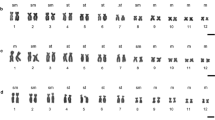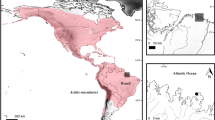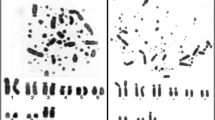Abstract
A cytogenetic study of Pseudis specimens from three localities in Rio Grande do Sul State, the southernmost Brazilian, was performed to identify karyotypic characteristics that could account for differences in vocalization pattern and body size. Individuals from around Tainhas were compared to those of São Jerônimo and Eldorado do Sul. Specimens from these latter two localities were identified as Pseudis minuta, while those from the former were classified as Pseudis sp. (aff. minuta). The populations from São Jerônimo and Eldorado do Sul had 2n = 24 chromosomes, classified as metacentric, submetacentric and subtelocentric. The population from Tainhas had 2n = 28 chromosomes, with four pairs of telocentric chromosomes. Modelling of these 28 chromosomes and testing for fusion in the centromeric/telomeric regions yielded a karyotype of 2n = 24 chromosomes, similar to that of the other populations. The similarity was reinforced by the location of the NORs and heterochromatin. The Tainhas population showed an increase in heterochromatin, as seen by the presence of additional C-bands, especially in the telocentric chromosomes. These data suggest that the two karyotypes described in this work had a common ancestry. There is evidence that the differentiation of these karyotypes may have occurred by chromosome fission and heterochromatin addition. Based on the present karyotype (2n = 28) and on morphological and vocalization studies by other researchers, we conclude that the Tainhas population may represent a new species.
Similar content being viewed by others
References
Batistic, R.F., 1989. Aspectos citogenéticos da evolução em Phyllomedusa (Anura, Amphibia). PhD Thesis. Faculty of Medicine, Ribeirão Preto, São Paulo, 203 pp.
Barrio, A & D.P. Rubel, 1970. Caracteristicas del cariótipos de los pseudidos. Physis (Tomo 29) 79: 505–510.
Beçak, M.L., L. Denaro & W. Beçak, 1970. Polyploidy and mechanisms of karyotypic diversification in Amphibia. Cytogenetics 9: 225–238.
Bogart, J.P., 1973. Evolution of anuran karyotypes, pp. 337–349 in Evolutionary Biology of the Anurans: Contemporary Research on Major Problems, edited by J.L. Vial. University of Missouri Press, Columbia.
Bogart, J.P., 1991. The influence of life history on karyotypic evolution in frogs, pp. 233–257 in Amphibian Cytogenetics and Evolution. Academic Press, San Diego.
Cole, C.J., 1974. Chromosome evolution in selected treefrogs including casque-headed species Pternohyla, Triprion, Hyla and Smilisca). Am. Mus. Novitat. 2541: 1–10.
Green, M.D. & S.K. Sessions, 1991. Nomenclature for chromosomes, pp. 431–432 in Amphibian Cytogenetics and Evolution. Academic Press, San Diego.
Guerra, M., 1988. Variação e evolução cromossômica: variação estrutural, pp. 112–124 in Introdução à citogenética geral. Editora Guanabara, Rio de Janeiro.
Howell, W.M. & D.A. Black, 1980. Controlled silver staining of nucleolus organizer regions with a protective colloidal developer: a 1-step method. Experientia 36: 1014–1015.
King, M., 1980. C-banding studies on Australian hylid frogs: secondary constriction structure and the concept of euchromatin transformation. Chromosoma 80: 191–217.
King, M., N. Contreras & R.L. Honeycutt, 1990. Variation within and between nucleolar regions in Australian hylid frogs (Anura) shown by 18S and 28S in situ hybridization. Genetics 80: 17–29.
King, M., 1991. The evolution of the amphibian genome, pp. 359–391 in Amphibian Cytogenetics and Evolution, edited by Green, M.D. & S.K. Sessions. Academic Press, San Diego.
Kwet, A., 2000. The genus Pseudis (Anura: Pseudidae) in Rio Grande do Sul, southern Brazil, with description of a new species. Amphibia-Reptilia 21: 39–55.
Miura, I., M. Nishioka, L.J. Bordikin & Z. Wu, 1995. The origin of the brown frogs with 2n=24 chromosomes. Experientia 51: 79–188.
Morescalchi, A., 1973. Amphibia, pp. 233–348 in Cytotaxonomy and Vertebrate Evolution, edited by A.B. Chiarelli & E. Capana. Academic Press, New York.
Savage, J.M., 1973. The geographic distribution of frogs: patterns and predictions, pp. 351–445 in Evolutionary Biology of the Anurans: Contemporary Research and Major Problems, edited by J.L. Vial. University of Missouri Press, Columbia.
Schmid, M., 1982. Chromosome banding in Amphibia VII. Analysis of the structure and variability of NORs in Anura. Chromosoma 87: 327–344.
Schmid, M, C. Steinlein, W. Feichtinger & M. Poot, 1993. Chromosome banding in Amphibia. XVIII. Karyotype evolution and genomic size variation in Pleurodema (Anura, Leptodactylidae). Cytogenet. Cell. Genet. 62: 42–48.
Stephenson, E.M., E.S. Robinson & N.G. Stephenson, 1972. Karyotypic variation within the genus Leiopelma (Amphibia, Anura). Can. J. Genet. Cytol. 14: 691–702.
Author information
Authors and Affiliations
Rights and permissions
About this article
Cite this article
Busin, C.S., Vinciprova, G. & Recco-Pimentel, S.M. Chromosomal rearrangements as the source of variation in the number of chromosomes in Pseudis (Amphibia, Anura). Genetica 110, 131–141 (2000). https://doi.org/10.1023/A:1017957716678
Issue Date:
DOI: https://doi.org/10.1023/A:1017957716678




